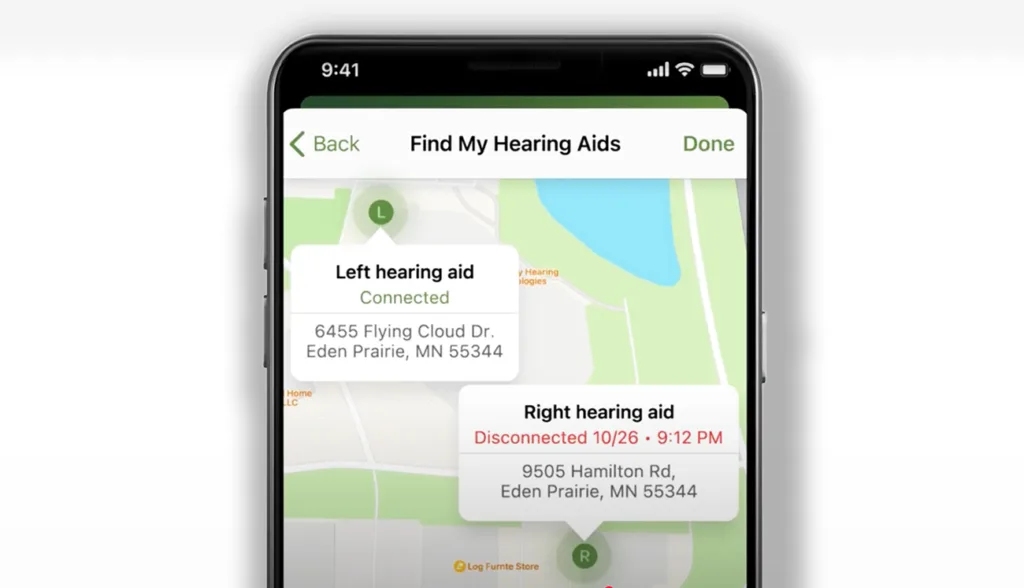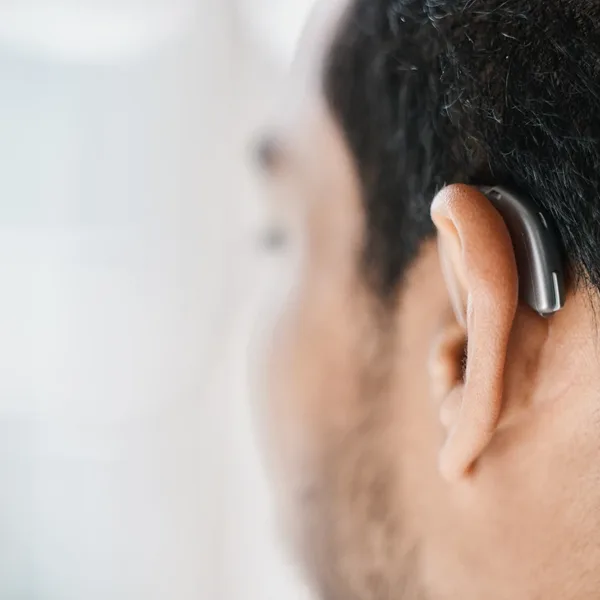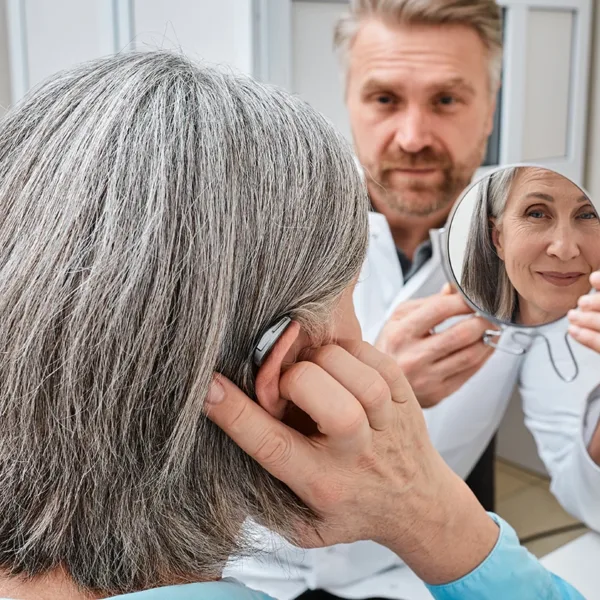Modern hearing aids are smaller, lighter, and more discreet than ever. While these advancements offer many benefits, small items also tend to be a little harder to find if accidentally misplaced. Fortunately, tracking a lost hearing aid is easier than ever. Some of today’s most advanced hearing aids come with a built-in feature and smartphone apps specifically designed to help you track a lost hearing aid. Think of it like the “find my” feature many smartphones, tablets, and laptops have now, but for your hearing devices!
In this guide, we explain how the Find My Hearing Aids app feature works and how to use it. We also provide tried and true tips on how to locate a lost hearing aid, so you find your device even if it doesn’t have built-in tracking.
How to Track a Lost Hearing Aid

Many prescription hearing aids have Bluetooth connectivity features that allow you to wirelessly connect them to other electronics like your smartphone or tablet. This makes it possible to stream audio from phone calls, TV shows, podcasts, and more, all directly to your hearing devices.
Bluetooth hearing aids also allow you to adjust volume, change programs, and access other features through compatible smartphone apps. Hearing aid apps like My Audibel and Thrive Hearing Control also have a built-in feature to help you find lost hearing aids quickly and easily.
This tool is called Find My Hearing Aids.
How Find My Hearing Aids Works
Using built-in Bluetooth and GPS technology, the Find My Hearing Aid tool in the My Audibel and Thrive Hearing Control apps can pinpoint the exact location of each of your hearing aids.
If you’ve lost your hearing aid outside of your immediate proximity, it will appear on the map labeled as “disconnected.” The map will also display the date, time, and address of the last known location that you had it connected to your phone.
If your hearing aid is nearby and still connected to your phone, it will appear on the map labeled as “connected.” The map will also display a proximity gauge that indicates how close or far you are from the device. This is essentially a “hot” and “cold” signal to help guide you toward the precise location of your device. The closer you are, the stronger the signal becomes.
How to Use the Find My Hearing Aids App Feature
To use the Find My Hearing Aids app feature, you need to download a companion app like My Audibel or Thrive and pair your hearing aids to your device. You will also need to ensure your phone’s Bluetooth and location services are enabled.
Here’s a step-by-step guide to how to set up and use the Find My Hearing Aids app feature:
- Download the App: Download the My Audibel or Thrive app onto your smartphone or tablet.
- Enable Permissions: When prompted, enable location services on your phone or tablet and give the app permission to use them.
- Pair Your Hearing Aids: Make sure your phone’s Bluetooth is turned on, and then follow the app’s instructions to connect your hearing aids to it.
- Using Find My Hearing Aids:
- First, open the app and navigate to “Find My Hearing Aids” in the menu.
- A map will display the last known address where your hearing aids were connected to your phone.
- Each hearing aid will be displayed on the map independently, even if they are in the same place.
- If your hearing aids are nearby, you’ll see a signal strength indicator bar. As you get closer to your hearing aids, the signal strength will increase.
- If your hearing aids are not within Bluetooth range, the map will display the date, time, and address of the last known location that it was connected to your phone.
Remember, the Find My Hearing Aids feature only works if your Bluetooth and location services are enabled for the app in your phone or tablet’s settings. To ensure you get the most accurate location information, it’s best to set your location sharing settings to “Always”.
What to Do if You Can’t Find Your Hearing Aid
If your hearing aids don’t have an app or tracking capabilities, don’t worry—there are still plenty of ways to track down a lost device. Many times, it is simply misplaced and can be found with a strategic search. The first step is to stay calm and use the tools available to you.
Here are some effective tips to locate a lost hearing aid:
1. Look in the Most Obvious Places First
If your hearing aid is missing, the first places you should check are the most obvious ones. It’s easy to quickly skip the most logical spots like the charging case or your nightstand, but there is no harm in looking.
Even if you don’t find your hearing aid in these places, it still helps cover all your bases and narrows down your search a bit more.
2. Retrace Your Steps
After checking the most obvious places, try working backwards. Think back to the last time you remember having your hearing aids. Re-trace your path from that point forward, paying close attention to where you went and what you were doing. Check the pockets of clothes you’ve changed out of, your car, or places where you may have removed them, like in the bathroom or bedroom before a shower.
If you’ve gone anywhere outside of your home, try calling the places you went to ask if anyone turned it in or if they have a lost-and-found.
3. Check Unusual Spots
Once you’ve checked the more common places a missing hearing aid could be hiding, it’s time to check the more unusual ones. It’s normal to accidentally set something down without thinking, or in a place it doesn’t belong, especially if you are distracted in some way. Check places like bags, pockets, junk drawers, the fridge and freezer, and even garbage cans.
Do you have any pets or young children in your home? A curious cat may have batted your hearing aid off the counter and under the stove, fridge, or nearby piece of furniture. A dog may have moved it to their bed or favorite hiding spot. Or a young child may have mistaken it for a toy.
Even if it seems unlikely, it’s a good idea to look for your hearing aids in these more unusual places just in case.
4. Leave No Stone Unturned
If you still can’t find your hearing aid, it’s time to get thorough. Check clothing, laundry bins, and bedding where your device could be hidden out of sight. Take a flashlight and get down on the floor to look under and behind every piece of furniture. Look under cushions, between couch pillows, or even beneath furniture where a small device could easily fall and get stuck.
The key is to systematically rule out every possibility. It might even be helpful to go room by room and make a list of all the places you’ve checked to ensure no stone is unturned.
5. Stop Looking (Temporarily)
While it may sound counterintuitive, sometimes the best thing to do is stop looking for a bit. Try taking a break from searching for your lost hearing aid and doing something else. Things sometimes have a strange way of appearing in unexpected places when you stop actively looking.
Distracting yourself with another activity can also help reduce the stress and pressure of the situation, letting your thoughts and nerves calm down a bit. This can help jog your memory about where you left your device or what you were doing the last time you saw it. Plus, returning to your search with fresh eyes may give you a better chance of finding it.
6. Ask for Help
If you’re really at a loss, sometimes a new perspective is all you need. Ask a family member or close friend to help you look. Another set of eyes can make all the difference when looking for a lost hearing aid. This is especially true if you’ve been searching for a while.
They may be able to think of new places to look or spot something you missed.
7. Contact Your Hearing Care Provider
If all else fails, it’s time to contact your hearing care provider. They can help you in several ways. For one, they may be able to check if your device has a tracking feature you didn’t know about.
They can also advise you on any warranty coverage your devices may be under and your best replacement options, so that you can get back to better hearing as soon as possible. Your specialist may also have a loaner device available that you can use until your new hearing aids come in.
Protect Your Investment and Health with the Latest Hearing Technology at Audibel
Thanks to advancements in technology, lost hearing aids can be located using built-in tracking features and a user-friendly smartphone app. These Find My Hearing Aid features leverage Bluetooth and GPS to help you locate a missing device with ease.
Whether you’re looking for a new hearing aid or need assistance using your Find My Hearing Aid app, the specialists at Audibel are here to help. Find a clinic near you today and get the expert hearing care you deserve.







Have a question or Comment?